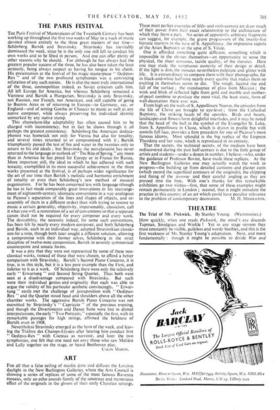ART
FOR all that a false ceiling of muslin dims and diffuses the London daylight in the New Burlington Galleries, where the Arts Council is showing a series of replicas of some of the most famous Ravenna mosaics, only an.echo sounds faintly of the sonorous and mysterious effect of the originals in the gloom of their early Christian settings
These most perfect examples of fifth- and sixth-century art draw much of their power from their exact relationship to the architecture of which they form a part. No series of apparently arbitrary fragments can suggest, for example, the grave progression, of the twenty-five hieratic martyrs in the nave of S. Appollinare, the impressive cupola of the Arian Baptistry or the apse of S. Vitale.
One is afforded something quite different, something which is impossible in the shrines themselves—an opportunity to sense the physical, the sheer sensuous, tactile quality, of the mosaics. Here one may study the sumptuous austerity of their design in detail. If the light is dim, the mosaics nevertheless palpitate and glitter with life. It is extraordinary to compare them with their photographs, for in black-and-white half-tone nearly every quality that makes them so exciting in themselves seems to die. The rough, faceted rise and fall of the surface ; the translucence of glass from Murano ; the wink and blink of reflected light from gold and marble and mother- of-pearl combine to produce the most vital, the least static, form of wall-decoration there ever was.
From high on the walls of S. Appollinare Nuovo, the episodes from the life of Christ are brought to eye-level ; from the Cathedral Baptistry, the striking heads izif the apostles. Birds and beasts, landscapes and flowers form delightful interludes, and it may be noted that the head of the bull in the symbol of the Evangelist St. Luke, from S. Appollinare in Classe, which is drawn in profile but with nostrils full face, provides a firm precedent for one of Picasso's most famous idioms. Most splendid is the big replica of the Empress Theodora and her suite, which is reproduced in its entirety.
That the secrets, the technical secrets, of the medium have been rediscovered during the past half-century is due to the little group of artists and students—under a dozen in number, I believe—who, under the guidance of Professor Bovini, have made these replicas. At the New Burlington Galleries one may actually watch the work in progress—the building up from detailed cartoons and plaster casts (which record the superficial contours of the originals), the chipping and fining of the tesserae and their careful angling as they are pressed into the lime. With one's thanks for this remarkable exhibition go two wishes—first, that some of these examples might remain permanently in London ; second, that it might stimulate the practice in this country of an art which could have peculiar relevance to the problem of contemporary decoration. M. H. MIDDLETON.










































 Previous page
Previous page